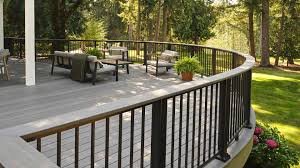
Prioritize Safety and Style with Custom Handrails Built to Last
When choosing the right handrail system, consider factors like durability, design, and material to ensure it complements your space while meeting safety standards and esthetic preferences.
From contemporary elegance to classic charm, our experienced team will help you discover the ideal solution.
Let’s talk about how we can bring your vision to life—reach out to us now to explore your options!
What Railing Material is Best for YOU?
-

Natural Wood
Types: Oak, maple, pine, cedar, or exotic hardwoods like ipe.
Benefits: Timeless appeal, customizable through staining or painting, warm and natural look.
Ideal For: Traditional or rustic designs, indoor and outdoor spaces.
Pros:
Classic and natural aesthetic.
Customizable with stains or paint.
Wide variety of wood types and finishes.
Warm, traditional look.
Cons:
Requires regular maintenance (sealing, staining, or painting).
Prone to rot, warping, and insect damage in outdoor settings.
Shorter lifespan compared to metal or composite.
-

Metal
Types: Stainless steel, aluminum, wrought iron, or brass.
Benefits: Durable, low maintenance, sleek and modern aesthetic, often powder-coated for added protection.
Ideal For: Contemporary or industrial designs, high-traffic areas.
Pros:
Extremely durable and long-lasting.
Low maintenance, especially stainless steel or powder-coated options.
Modern and sleek design.
Resistant to weather and corrosion (with proper coating).
Cons:
Can get hot to the touch in direct sunlight.
Higher upfront cost, especially for stainless steel or wrought iron.
Limited customization compared to wood.
-

Glass
Types: Tempered or laminated glass panels.
Benefits: Modern and elegant, maximizes visibility, makes spaces feel open and spacious.
Ideal For: Balconies, decks with scenic views, indoor staircases.
Pros:
Provides an open, airy feel and unobstructed views.
Modern and elegant appearance.
Easy to clean and maintain.
Resistant to weather and corrosion.
Cons:
Can be expensive to install.
Prone to fingerprints and smudges, requiring frequent cleaning.
May require tempered glass for safety, increasing cost.
Fragility compared to metal or wood (though tempered glass is strong).
-

Cable
Materials: Stainless steel or coated cables.
Benefits: Minimalist and unobtrusive, durable, low maintenance, allows for clear views.
Ideal For: Outdoor decks, modern designs.
Pros:
Minimalist design that doesn’t block views.
Durable and low maintenance.
Modern and sleek aesthetic.
Resistant to weather and corrosion when made from stainless steel.
Cons:
Installation can be tricky and time-consuming.
Higher initial cost than traditional options.
Can loosen over time and require occasional tensioning.
-

Composite/PVC/Vinyl
Benefits: Combines durability with low maintenance, resists rot and insects, mimics the look of wood.
Ideal For: Outdoor spaces where low upkeep is a priority.
Low maintenance and easy to clean.
Resists rot, insects, and weather damage.
Mimics the appearance of wood.
Long-lasting and durable.
Cons:
Higher upfront cost than wood.
Limited customization compared to wood.
Can fade or discolor over time with UV exposure.
-

Mixed Materials
Examples: Wood and metal, glass and steel, or composite and cable.
Benefits: Combines the strengths and aesthetics of different materials for a custom look.
Ideal For: Tailored designs that balance beauty, function, and longevity.
Pros:
Combines the strengths and aesthetics of multiple materials.
Allows for highly customized designs.
Can balance cost-effectiveness with premium looks.
Versatile for various styles and spaces.
Cons:
More complex installation process.
Potential for mismatched durability if materials age differently.
Higher cost due to using multiple materials.







